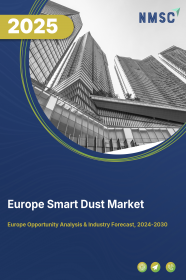
Europe Smart Dust Market by Component (Sensors, Active Optical Transmission, Passive Optical Transmission, Optical Receiver, Analog I/O, Signal Processing, Control Circuitry, Power Source, and Others), by Manufacturing Process (3D Printing and Microfabrication), by Type (Biodegradable and Non-Biodegradable) and Others– Opportunity Analysis and Industry Forecast 2026-2030
Industry: Semiconductor & Electronics | Publish Date: 14-Feb-2025 | No of Pages: 183 | No. of Tables: 124 | No. of Figures: 89 | Format: PDF | Report Code : SE1939
US Tariff Impact on Europe Smart Dust Market
Trump Tariffs Are Reshaping Global Business
Market Definition
The Europe Smart Dust Market will value at USD 65.4 million in 2025 and is predicted to reach USD 184.0 million by 2030, at a CAGR of 19.7% from 2026 to 2030. Advanced contemporary technologies prioritize miniaturization and automation. Computing's evolution has been characterized by enhanced connectivity, the reduction in computing device sizes, and increased global communication. The soaring popularity of smaller computing devices such as mobile phones and handheld computers, combined with the development of micro sensors and transistors, has mainly accelerated further nano computing device development.
Hence, increased interaction with the environment and the emergence of small computing elements offers enriched opportunities to reshape interactions among computers, humans, and the environment. These aspects have prompted the creation of Smart Dust, comprising various microelectromechanical systems (MEMS), including sensors capable of detecting light, temperature, magnetism, vibration, or chemicals, among others. Typical Smart Dust includes nano-structured silicon sensors, which can independently orient, sense, assemble, and report environmental data.
Integration of Smart Dust in the Medical Sector is Expected to Drive the Europe Market in the Coming Years
The assimilation of smart dust into the medical realm is poised to revolutionize healthcare practices in the country in the years to come. With its diminutive size and wireless connectivity, smart dust sensors can be implanted within the human body to monitor various vital signs, identify early indications of illness, and even deliver targeted treatments. This technology enables real-time data gathering, leading to more precise diagnoses and personalized medical interventions.
Additionally, the continuous monitoring facilitated by smart dust enhances preventive care and allows for timely interventions, ultimately improving patient outcomes and reducing healthcare costs. Consequently, the adoption of smart dust in the medical sector is anticipated to fuel significant growth in the smart particle market as healthcare providers increasingly recognize its potential to transform healthcare service delivery.
Industrial Monitoring Capabilities of Smart Dust is Expected to Increase its Adoption in Europe
The industrial monitoring capabilities of smart dust in the country are poised to significantly enhance its adoption in the coming years. With its diminutive size and wireless connectivity, smart dust sensors can be deployed across industrial settings to collect real-time data on various parameters such as temperature, pressure, and vibration. This data enables proactive maintenance, enhances operational efficiency, and minimizes downtime, leading to cost savings and improved productivity for industries.
Additionally, the scalability and versatility of smart dust technology make it adaptable to a wide range of industrial applications, from manufacturing plants to oil and gas facilities. As industries increasingly recognize the value of data-driven insights for optimizing operations and ensuring regulatory compliance, the demand for smart dust solutions is expected to soar, driving its widespread adoption.
Privacy Concerns Associated with Smart Dust Hinders the Europe Market Growth
Concerns about privacy connected with smart dust present a substantial impediment to market development in the country. Despite the groundbreaking capabilities it offers for data collection and analysis, the continuous monitoring it enables gives rise to concerns about individual privacy and data protection. Users are concerned about the potential for unauthorized access to sensitive information gathered by smart dust sensors and the risk of covert surveillance.
These concerns are further exacerbated by the widespread deployment of smart dust, prompting questions about consent and control over personal data. Consequently, individuals, businesses, and regulatory bodies are reluctant to fully embrace smart dust technology, hindering its market expansion as they seek effective solutions to address these privacy concerns.
Introduction of Smart Dust in Space Research is Expected to Create Ample Opportunities in the Europe Market
Smart dust is expected to have a significant role in upcoming space missions in the country. Nanosensors greatly enhance high-performance materials or highly efficient propulsion systems. Smart dust sensors could be placed in space or on the surface of a terrestrial planet where traditional detection systems would be impractical or difficult to install. Different international space exploration organizations are conducting various research and development activities on the use of nanoparticles such as smart dust to gather data during unmanned expeditions in outer space.
Conversely, traditional rocket engines rely on chemical propulsion, and all existing spacecraft use some form of chemical rockets that require launching. However, researchers and space organizations are advancing electric propulsion (EP) systems as they can significantly decrease the propellant mass required in traditional chemical rockets, thus increasing payload capacity while decreasing launch mass. Some electric propulsion (EP) concepts propose using electrostatically charged and accelerated nanoparticles as propellants, alongside using smart dust as sensor arrays. This allows for millions of micron-sized nanoparticle thrusters to be integrated into one square centimeter, enabling the creation of highly scalable thruster arrays for future electric propulsion systems. The mentioned applications of smart dust are expected to generate ample opportunities in the future.
Germany Holds a Dominant Share in Europe Market
Germany holds a dominant share in the smart dust market in Europe due to several factors. Firstly, Germany boasts a robust economy with a strong focus on research and development, particularly in the fields of engineering and technology. This has enabled German companies to pioneer advancements in smart dust technology, making them leaders in the industry.
Additionally, Germany's well-established infrastructure and supportive government policies have created a conducive environment for the growth of innovative tech companies. Furthermore, Germany's strategic location in the heart of Europe allows for easy access to markets across the continent, facilitating the distribution of smart dust products. Overall, Germany's combination of technological expertise, supportive ecosystem, and favorable location has propelled it to the forefront of the smart dust market in Europe.
Europe is Expected to Show a Steady Growth in Europe Market
The Europe is anticipated to demonstrate a consistent growth trajectory in the smart dust market within Europe due to several key factors. Firstly, the Europe boasts a robust infrastructure and advanced technological landscape, fostering an environment conducive to the development and adoption of innovative technologies such as smart dust.
Additionally, the country's strong focus on research and development, coupled with government initiatives to promote digital innovation, creates a supportive ecosystem for smart dust solutions to thrive. Furthermore, the Europe's diverse range of industries, including healthcare, manufacturing, and agriculture, presents ample opportunities for the application of smart dust across various sectors, driving market growth. Lastly, increasing awareness about the benefits of smart dust in enhancing operational efficiency, reducing costs, and enabling real-time monitoring is expected to fuel demand and contribute to the steady expansion of the market in the Europe.
Competitive Landscape
Various market players operating in the Europe smart dust market include HP, Cisco Systems Inc, Analog Devices, Lightricity Ltd, IBM, CubeWorks, SINTEF, Sonardyne International Ltd, General Electric, and Hitachi.
Europe Smart Dust Market Key Segments
By Component
-
Sensors
-
Active Optical Transmission
-
Passive Optical Transmission
-
Optical Receiver
-
Analog I/O
-
Signal Processing
-
Control Circuitry
-
Power Source
-
Others
By Manufacturing Process
-
3D Printing
-
Microfabrication
By Type
-
Biodegradable
-
Non-Biodegradable
By Applications
-
Humidity Monitoring
-
Temperature Monitoring
-
Surveillance
-
Pressure & Stress Monitoring
-
Sound Monitoring
-
Others
By End User
-
Aerospace & Defense
-
Pharmaceutical & Lifesciences
-
Agriculture
-
Industrial
-
Government
-
Construction
-
Transportation & Logistics
-
Telecommunication
-
Others
By Country
-
UK
-
Germany
-
France
-
Italy
-
Russia
-
Rest of Europe
REPORT SCOPE AND SEGMENTATION:
|
Parameters |
Details |
|
Market Size in 2025 |
USD 65.4 Million |
|
Revenue Forecast in 2030 |
USD 184.0 Million |
|
Growth Rate |
CAGR of 19.7% from 2026 to 2030 |
|
Analysis Period |
2025–2030 |
|
Base Year Considered |
2025 |
|
Forecast Period |
2026–2030 |
|
Market Size Estimation |
Million (USD) |
|
Growth Factors |
|
|
Countries Covered |
6 |
|
Companies Profiled |
10 |
|
Customization Scope |
Free customization (equivalent up to 80 analysts working hours) after purchase. Addition or alteration to country, regional & segment scope. |
|
Pricing and Purchase Options |
Avail customized purchase options to meet your exact research needs. |
KEY PLAYERS
-
HP
-
Cisco Systems Inc.
-
Analog Devices
-
Lightricity Ltd.
-
IBM
-
CubeWorks
-
SINTEF
-
Sonardyne International Ltd.
-
General Electric
-
Hitachi

















 Speak to Our Analyst
Speak to Our Analyst




















